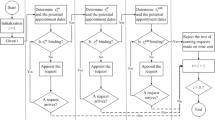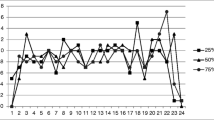Abstract
Long waiting times are a major reason for patient dissatisfaction in outpatient clinics. Existing research in patient scheduling has established the relationship between the number of providers and patient waiting times. However, no research has explored the problem by considering patient flow through multiple stages with multiple servers. In this paper, a Multispecialty Outpatient Clinic Appointment Planning Algorithm (MOCAPA) is developed. The goal of the planning algorithm is to reduce patient check-in waiting times in multispecialty clinics by exploring the patient interaction with multiple stages in the system (i.e., the clinic front desk and the providers). The paper results show that in a multi-stage outpatient clinic, patient waiting times can be reduced by (1) classifying patients according to their status at the clinic (i.e., new vs. existing) and (2) balancing the patient type ratio of arrivals per appointment time period.


Similar content being viewed by others
Data Availability
Raw data were generated at the outpatient clinic. Derived data supporting the findings of this study are available from the corresponding author on request.
References
Ahmadi-Javid A, Jalali Z, Klassen K (2017) Outpatient appointment systems in healthcare: a review of optimization studies. Eur J Oper Res 258(1):3–34
Anderson RT, Camacho FT, Balkrishnan R (2007) Willing to wait?: the influence of patient wait time on satisfaction with primary care. BMC Health Serv Res 7(1):31
Pérez E, Dzubay DP (2021) A scheduling-based methodology for improving patient perceptions of quality of care in intensive care units. Health Care Management Science:1–13
B Mocarzel D Shelton B Uyan E Pérez JA Jimenez L DePagter (2013) Modeling and simulation of patient admission services in a multi-specialty outpatient clinic. Paper presented at the, 2013 Winter Simulations Conference (WSC) DC, USA Washington
Walker D, Shanks E, Montoya D, Weiman C, Pérez E, DePagter L (2015) Towards a simulation based methodology for scheduling patient and providers at outpatient clinics. Paper presented at the 2015 Winter Simulation Conference (WSC), Huntington Beach, CA, USA,
Srinivas S, Ravindran AR (2020) Designing schedule configuration of a hybrid appointment system for a two-stage outpatient clinic with multiple servers. Health care Management Science:1–27
Vahdat V, Namin A, Azghandi R, Griffin J (2019) Improving patient timeliness of care through efficient outpatient clinic layout design using data-driven simulation and optimisation. Health Systems 8(3):162–183
Sowle T, Gardini N, Vazquez FVA, Pérez E, Jimenez JA, DePagter L (2014) A simulation-IP based tool for patient admission services in a multi-specialty outpatient clinic. Paper presented at the Winter Simulation Conference (WSC), Savannah, GA, USA,
Erhard M, Schoenfelder J, Fügener A, Brunner JO (2018) State of the art in physician scheduling. Eur J Oper Res 265(1):1–18
Kuo Y-H, Balasubramanian H, Chen Y (2019) Medical appointment overbooking and optimal scheduling: tradeoffs between schedule efficiency and accessibility to service. Flex Serv Manuf J 32(1):72–101
Pérez E, Ntaimo L, Malavé C, Bailey C, McCormack P (2013) Stochastic online appointment scheduling of multi-step sequential procedures in nuclear medicine. Health Care Manag Sci 16(4):281–299
Perez E, Anandhan V, Novoa C (2020) A simulation-based planning methodology for decreasing patient waiting times in pure walk-in clinics. International Journal of Information Systems in the Service Sector 12(3):34–54
Reese HD, Anandhan V, Pérez E, Novoa C (2017) Improving patient waiting time at a pure walk-in clinic. Paper presented at the 2017 Winter Simulation Conference (WSC), Las Vegas, NV, USA,
DP Dzubay E Pérez (2016) The impact of system factors on patient perceptions of quality of care. Paper presented at the, 2016 Winter Simulation Conference (WSC) DC, USA Washington
Laan C, van de Vrugt M, Olsman J, Boucherie RJ (2018) Static and dynamic appointment scheduling to improve patient access time. Health Systems 7(2):148–159
Swisher JR, Jacobson SH, Jun JB, Balci O (2001) Modeling and analyzing a physician clinic environment using discrete-event (visual) simulation. Comput Oper Res 28(2):105–125
Robinson LW, Chen RR (2010) A comparison of traditional and open-access policies for appointment scheduling. Manuf Serv Oper Manag 12(2):330–346
Gupta D, Wang L (2008) Revenue management for a primary-care clinic in the presence of patient choice. Oper Res 56(3):576–592
Qu X, Rardin RL, Williams JA (2011) Single versus hybrid time horizons for open access scheduling. Comput Ind Eng 60(1):56–65
Xie X, Fan Z, Zhong X, Engineering (2021) Appointment capacity planning with overbooking for outpatient clinics with patient no-shows. IEEE Transactions on Automation Science
Pan X, Geng N, Xie X (2021) Appointment scheduling and real-time sequencing strategies for patient unpunctuality. Eur J Oper Res 295(1):246–260
Qu X, Rardin RL, Williams JAS, Willis DR (2007) Matching daily healthcare provider capacity to demand in advanced access scheduling systems. Eur J Oper Res 183(2):812–826
Kopach R, DeLaurentis P-C, Lawley M, Muthuraman K, Ozsen L, Rardin R, Wan H, Intrevado P, Qu X, Willis D (2007) Effects of clinical characteristics on successful open access scheduling. Health Care Manag Sci 10(2):111–124
Muthuraman K, Lawley M (2008) A stochastic overbooking model for outpatient clinical scheduling with no-shows. IIE Trans 40(9):820–837
Srinivas S (2016) Evaluating the impact of nature of patient flow and patient availability on the performance of appointment scheduling rules in outpatient clinics. International Journal of Operations and Quantitative Management 22(2):93–118
Erdogan SA, Gose A, Denton BT (2015) Online appointment sequencing and scheduling. IIE Trans 47(11):1267–1286
Hoseini B, Cai W, Abdel-Malek L (2018) A carve-out model for primary care appointment scheduling with same-day requests and no-shows. Operations Research for Health Care 16:41–58
Ala A, Chen F (2022) Appointment scheduling problem in complexity systems of the healthcare services: a comprehensive review. Journal of Healthcare Engineering 2022
Author information
Authors and Affiliations
Corresponding author
Ethics declarations
Conflict of Interest
The author declares no competing interests.
Additional information
Publisher’s Note
Springer Nature remains neutral with regard to jurisdictional claims in published maps and institutional affiliations.
Rights and permissions
Springer Nature or its licensor holds exclusive rights to this article under a publishing agreement with the author(s) or other rightsholder(s); author self-archiving of the accepted manuscript version of this article is solely governed by the terms of such publishing agreement and applicable law.
About this article
Cite this article
Pérez, E. An Appointment Planning Algorithm for Reducing Patient Check-In Waiting Times in Multispecialty Outpatient Clinics. Oper. Res. Forum 3, 52 (2022). https://doi.org/10.1007/s43069-022-00165-5
Received:
Accepted:
Published:
DOI: https://doi.org/10.1007/s43069-022-00165-5




